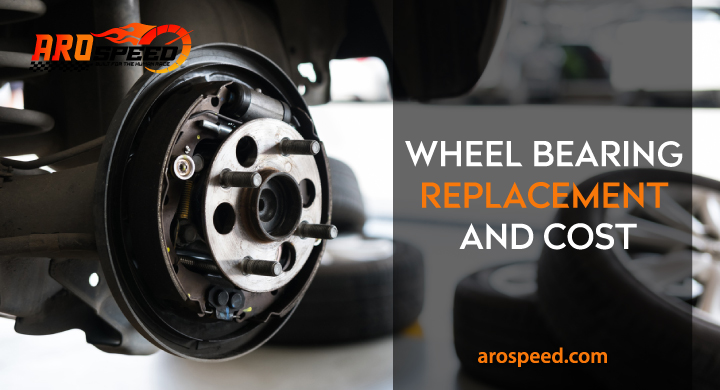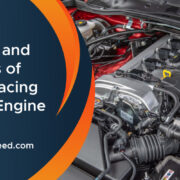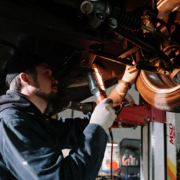Wheel bearing replacement and cost are crucial issues addressed in this thorough reference. If you’ve heard odd noises coming from your car’s wheels or noticed that it’s been handled differently, it could be time to consider replacing your wheel bearings. In addition, this article also comprehensively addresses crucial issues with wheel bearings, including their importance, failure indicators, replacement procedures, and associated costs.
Table of Contents
Understanding the Importance of Wheel Bearings in Your Vehicle
Wheel bearings are crucial components of a vehicle’s suspension system. It help to minimize friction, stabilize the vehicle, and ensure smooth wheel movement. They deteriorate with time from repeated exposure and use, necessitating prompt Wheel Bearing Replacement and Cost. Recognize their importance for driving performance and safety. To make wise choices, be aware of associated replacement costs.
Signs that Indicate Wheel Bearing Problems
Unusual Noises
Have you ever noticed a strange humming, growling, or grinding noise coming from your vehicle’s wheels? It’s not a sound you want to ignore. These peculiar noises are often an indication of a worn-out wheel bearing. As the bearing deteriorates, it can emit various sounds, whose loudness varies with the speed and severity of the damage.
Imagine driving down the road, noticing a faint buzzing sound that progressively gets louder with each passing mile. This is a classic symptom of a bearing nearing the end of its life. A growling or grinding sound, on the other hand, indicates a more serious condition. These noises suggest that the bearing may be lacking proper lubrication or suffering from significant damage.
Remember, the key here is to pay attention to these unusual noises, especially when you’re in motion or making turns. Don’t brush them off as road noise or just a minor inconvenience. Instead, take the time to have your wheel bearings inspected and replaced if necessary. By addressing the issue promptly, you’ll avoid further damage and ensure a safer driving experience.
Vibrations
Have you ever experienced unsettling vibrations while driving? It’s not simply an irritation; it could indicate a faulty wheel bearing. A worn-out bearing disrupts wheel rotation, causing vibrations felt in the steering wheel and throughout the car.
Consider this: You’re driving down the interstate when you detect a slight tremor in your steering wheel. It may begin subtly, almost imperceptibly, but it gradually gets more pronounced and difficult to ignore. These vibrations are a sure sign that something is wrong with your wheel bearings.
Remember that as the bearing damage continues, the vibrations tend to worsen. They can become more evident at greater speeds, making your journey uncomfortable and perhaps endangering the handling of your car. Ensure safety and smooth running; test and replace wheel bearings at the first sign of vibrations.
Wheel Instability
Have you ever had the sensation that your wheels are loose or wobbly? This can be an alarming sign that your wheel bearing is deteriorating. The wheel bearing is vital in providing support and stability to the wheel, and when it begins to wear out, it can affect the control and safety of your car.
Consider the following scenario: You wiggle your wheel gently, and you detect some apparent play or side-to-side movement. If you feel your wheel isn’t securely anchored and experience wheel instability, it is a clear sign that your wheel bearing requires immediate attention.
Remember, driving with a failing wheel bearing can be risky. The compromised stability and control can make it challenging to maneuver your vehicle safely, especially during turns or sudden changes in direction. To prevent further damage and potential accidents, it’s essential to have your wheel bearings examined promptly if you suspect any wheel instability.
By staying vigilant and addressing these signs of a failing wheel bearing, you can ensure the safety, performance, and longevity of your vehicle. Don’t hesitate to consult with a professional mechanic who can provide expert guidance and replace the wheel bearings as needed. Your peace of mind and smooth ride are worth it.
The Wheel Bearing Replacement Process
The process of replacing a wheel bearing involves several important steps to ensure a successful and long-lasting repair. Replacing a wheel bearing typically involves the following steps:
Vehicle Preparation
Safety is paramount when working on any automotive repair. To begin, you’ll need to safely lift the vehicle using a jack and securely support it on jack stands.
This will provide a stable and elevated position for the necessary work. Next, remove the wheel associated with the bearing that requires replacement. To access the bearing, you’ll need to remove the brake caliper, typically secured in place by bolts or pins.
Bearing Removal
Now that the brake caliper and wheel are out of the way, you can concentrate on getting rid of the old bearing. Axle nut removal is the first step because it holds the bearing assembly to the axle. You might require a specialized instrument to loosen this nut as it is frequently tightened to a specific torque.
After removing the axle nut, disconnect the hub assembly and any other parts linked to the bearing. This may involve removing bolts, screws, or retaining clips. Mechanics commonly use specialized bearing pullers or press tools to extract the old bearing from the hub. These tools are designed to apply even pressure and safely separate the bearing from the hub without causing damage.
Cleaning and inspection
It’s critical to carefully clean the hub after removing the old bearing. To get rid of any dirt, grime, or leftovers from the old bearing, use an appropriate solvent or degreaser. A clean surface for the installation of the new bearing is ensured by cleaning the hub.
Examine the hub for any signs of wear or damage as it is being cleaned. Look for any flaws that could affect the replacement bearing’s performance, such as cracks, corrosion, or excessive wear. Before continuing with the installation, any faults that are found should be fixed.
New Bearing Installation
Now it’s time to install the new wheel bearing. Start by pressing the new bearing into the hub using a bearing press tool. Ensure that the bearing is aligned properly and fully seated in the hub.
Applying gentle, even pressure during the installation is crucial to prevent any damage. Once the new bearing is in place, reassemble the hub and related components in the reverse order of removal. This includes reattaching the hub assembly, securing it with bolts or screws, and reinstalling the axle nut to the manufacturer’s specified torque.
Final Checks
Before considering the job complete, it is essential to perform final checks to ensure the replacement has resolved the issues and that the vehicle operates smoothly. Carefully lower the vehicle from the jack stands and take it for a test drive.
Pay attention to any unusual noises, vibrations, or wheel instability that may have been present before the replacement. If everything feels and sounds normal, you can have confidence that the wheel bearing replacement was successful.
Remember, it’s always preferable to seek the help of a qualified mechanic if you’re not confident or skilled with this degree of vehicle maintenance. They are equipped with the skills, expertise, and specialized tools needed to replace wheel bearings securely and efficiently.
Wheel Bearing Replacement and Cost
The cost of wheel bearing replacement can vary depending on various factors. Here is a detailed breakdown of what influences the overall cost:
Vehicle Make and Model
The make and model of your vehicle play a significant role in determining the cost of wheel bearing replacement. Different vehicles have different designs and varying levels of complexity when it comes to accessing and replacing wheel bearings. Some vehicles may require more labor-intensive procedures, which can affect the overall cost. While bearing replacement and cost can vary depending on your vehicle’s specifications, it’s essential to consider the quality of the replacement parts and the expertise of the mechanic to ensure a successful and long-lasting repair.
Labor Rates
Labor rates vary by location and individual repair shops. Rates can be influenced by factors such as the shop’s reputation, overhead costs, and local market competition. In general, increasing labor costs will increase the replacement’s overall cost. To be sure you’re getting a fair price, it’s usually a good idea to acquire several quotations from reliable technicians in your region.
Original Equipment Manufacturer (OEM) or Aftermarket Parts
When changing a wheel bearing, you have the option of using OEM components or aftermarket substitutes. OEM parts are often more expensive because they are purchased directly from the automaker. On the other hand, aftermarket components are created by independent producers and are frequently more affordable. The entire cost of the replacement can be affected by the decision between OEM and aftermarket parts.
Single or Multiple Wheel Bearings
The cost will also depend on whether you need to replace a single wheel bearing or multiple bearings. If only one bearing is failing, you may choose to replace it individually. However, it is generally recommended to replace wheel bearings in pairs (both on the same axle) to ensure balanced performance. Replacing multiple bearings will increase the overall cost of the replacement.
A single wheel bearing repair normally costs between $150 and $400, including components and labor, considering these parameters. Keep in mind that this is an estimate; the final cost may vary depending on your situation. Consult with a qualified mechanic for an accurate breakdown of costs and a precise estimate based on your circumstances. Get multiple quotations to ensure a reasonable price without compromising quality. Timely and proper wheel bearing replacement is vital for your vehicle’s performance, safety, and longevity.
Determining the Lifespan of Wheel Bearings: Factors to Consider
The lifespan of a wheel bearing can vary depending on various factors, including driving conditions, vehicle usage, and maintenance practices. On average, a properly functioning wheel bearing can last between 80,000 to 100,000 miles. However, it’s important to note that this is just an estimate, and the actual lifespan can be influenced by several factors.
Driving conditions play a significant role in the wear and tear of wheel bearings. If you frequently drive on rough roads, or uneven surfaces, or encounter potholes, the bearings may experience increased stress, leading to accelerated wear. Similarly, if you frequently tow heavy loads or drive in mountainous terrain, the bearings may wear out sooner due to the increased strain.
Regular maintenance also plays a crucial role in the longevity of wheel bearings. Adequate lubrication is essential to reduce friction and prevent premature wear. Regularly inspecting and greasing the bearings as recommended by the vehicle manufacturer can help prolong their lifespan. Additionally, addressing any issues promptly, such as unusual noises or vibrations, can prevent further damage and extend the life of the bearings.
It’s crucial to pay attention to any strange noises (such as humming, growling, or grinding), vibrations, or wheel instability that could indicate a deteriorating wheel bearing. A skilled mechanic should check your wheel bearings if you observe any of these symptoms. They can evaluate the bearings’ state and decide whether replacement is required.
In the end, your vehicle’s particular circumstances will determine if you need to replace your wheel bearing. The lifespan of your wheel bearings can be increased and the need for premature replacements reduced with routine maintenance, careful driving, and fast attention to any problems.
Importance of Timely Replacement
You cannot overstate the importance of replacing your vehicle’s wheel bearings on schedule. Ignoring warning indications of a deteriorating wheel bearing can jeopardize your safety and your car’s health. Address these issues promptly to ensure safe operation and prevent future concerns.
Imagine this: As you continue to drive, one of your wheels begins to make an odd humming or grinding noise. Although it may be easy to brush it off as nothing more than a minor irritation, that noise might be a sign of a deteriorating wheel bearing. A worn-out bearing might make your wheel-less stable, causing erratic handling and possibly losing control.
Imagine the potential dangers of driving with a compromised wheel bearing. The bearing is in charge of supporting the weight of your car and enabling smooth wheel rotation. Driving while the bearing fails can have serious repercussions. It might result in a wheel breaking loose or locking up, which might cause you to lose control and put you, your passengers, and other drivers on the road at risk.
By promptly addressing wheel bearing issues, you ensure the safe operation of your vehicle and restore stability and functionality to your wheels. Delaying a deteriorating wheel bearing can lead to more problems and costly repairs, making timely replacement essential for both safety and peace of mind.
This is why: The hub and axle of the wheel assembly are subjected to additional tension when a wheel bearing begins to wear out. Over time, this added strain can cause damage to these parts as well. If left unattended, what could have been a relatively simple and affordable wheel bearing replacement may turn into a more extensive repair involving multiple components. This can significantly increase the repair costs and the time your vehicle spends in the shop.
You may avoid these extra issues and spare yourself time and money by taking quick action. To ensure the safety and integrity of the complete vehicle, you must replace the wheel bearings, not just the noisy wheel. Therefore, act quickly if you notice any indications that a wheel bearing is failing, such as odd noises, vibrations, or wheel instability. Consult a qualified mechanic, and have the problem fixed as soon as you can.
Your safety and the safety of those around you depend on the proper functioning of your vehicle’s wheel bearings. So, take a proactive approach and prioritize timely replacement. By doing so, you’ll ensure a smooth and secure ride, avoid further damage, and have peace of mind knowing that you’ve taken the necessary steps to keep yourself and others safe on the road.
Professional Wheel Bearing Diagnosis
Seeking the expertise of a professional mechanic is highly recommended when diagnosing wheel bearing issues. These skilled professionals have the knowledge and experience to accurately assess the condition of your wheel bearings and determine if a replacement is necessary. Let’s delve into the importance of a professional wheel-bearing diagnosis in more detail.
Imagine this scenario: You’ve noticed unusual noises or vibrations coming from your wheels, indicating a potential problem with the wheel bearings. While it may be tempting to rely on online resources or attempt a DIY diagnosis, consulting a professional mechanic offers numerous advantages.
First and foremost, professional mechanics possess the specialized knowledge required to diagnose wheel bearing issues accurately. They have extensive training and experience working with various vehicle makes and models, allowing them to quickly identify the source of the problem. Their expertise enables them to differentiate between wheel bearing issues and other potential causes, such as tire problems or suspension components.
Furthermore, professional mechanics have access to advanced diagnostic tools and equipment. These tools, such as wheel bearing play detectors or listening devices, can aid in pinpointing the exact location and severity of the problem. By utilizing these specialized tools, mechanics can provide a more precise diagnosis, leading to the appropriate repairs.
Another crucial aspect of a professional diagnosis is the ability to consider the overall condition of your vehicle. A professional mechanic will thoroughly inspect other related components, such as the hub, axle, and suspension, to ensure there are no additional issues or underlying problems. This comprehensive evaluation helps prevent overlooking potential problems that could impact the performance and longevity of your wheel bearings.
Moreover, a professional diagnosis provides peace of mind. Instead of relying on guesswork or online advice, you can trust the expertise and experience of a qualified mechanic. They will take the time to explain their findings and recommendations, addressing any questions or concerns you may have. This open communication allows you to make informed decisions about the necessary repairs.
Ultimately, a professional wheel-bearing diagnosis saves you time, money, and potential frustration. Rather than investing in unnecessary parts or performing incorrect repairs, you can rely on the accurate assessment provided by a professional mechanic. They can effectively address the root cause of the problem and guide you toward the most appropriate course of action.
In summary, a professional wheel bearing diagnosis is essential for accurately identifying and resolving issues with your wheel bearings. The expertise, specialized tools, and comprehensive evaluation offered by professional mechanics contribute to a more precise diagnosis and effective repairs. By entrusting your vehicle to the hands of a skilled professional, you can have confidence in the accuracy of the assessment and the quality of the repairs performed.
Genuine OEM Parts vs. Aftermarket Options
When it comes to replacing wheel bearings, you have two main options: genuine original equipment manufacturer (OEM) parts or aftermarket alternatives. Understanding the differences between these choices is crucial in making an informed decision. Let’s explore the topic of genuine OEM parts versus aftermarket options in more detail.
The same company that built your vehicle manufactures genuine OEM parts. These parts undergo specific design and engineering processes to meet the exact specifications and quality standards set by the manufacturer. They are seamlessly made to fit your vehicle’s make and model, ensuring optimal performance and compatibility.
Choosing genuine OEM parts for wheel bearing replacement offers several advantages. Firstly, you can have confidence in the quality and reliability of these components. Produced by the original manufacturer, genuine OEM parts undergo rigorous testing and adhere to strict standards to ensure they achieve the highest level of performance and durability. This quality assurance offers peace of mind, knowing that you are installing parts specifically designed for your vehicle.
Secondly, genuine OEM parts often come with warranties. These warranties protect you against manufacturing defects and provide coverage in case of premature failure. The warranty coverage can vary depending on the manufacturer and specific terms, but it offers an added layer of protection for your investment.
It’s crucial to keep in mind that genuine OEM parts are typically more expensive than aftermarket alternatives. The premium pricing reflects the components’ high quality, dependability, and brand reputation. Genuine OEM parts are a good option if you desire the assurance that comes with utilizing components straight from the car manufacturer and are prepared to spend more money for the highest caliber.
On the other hand, aftermarket components are created by independent producers. These producers produce spare parts that work with different car brands and models. A broader variety of options are available with aftermarket products in terms of brands, cost, and accessibility.
The potential cost savings is one of the main benefits of aftermarket components. They are typically less expensive than genuine OEM parts, which makes them a desirable alternative for those trying to cut repair costs. When choosing aftermarket components, care must be taken because quality and dependability can fluctuate across various brands and manufacturers. Researching reputable aftermarket brands and reading customer reviews can help ensure you choose a reliable and durable option.
While aftermarket parts may not carry the same brand recognition or come with OEM warranties, many reputable aftermarket manufacturers offer their warranties and guarantees to provide some level of assurance to customers.
When deciding between genuine OEM parts and aftermarket options, consider factors such as your budget, the importance of brand reputation and warranty coverage, and the specific needs of your vehicle. If you prioritize the highest level of quality, compatibility, and warranty protection, genuine OEM parts are the recommended choice. However, if cost savings and a wider range of options are more important to you, reputable aftermarket parts can be a suitable alternative.
Ultimately, the decision between genuine OEM parts and aftermarket options depends on your individual preferences, priorities, and budget. Consulting with a professional mechanic can provide valuable insights and guidance based on their experience and expertise in the field.
How to Make Your Wheel Bearings Last Longer?
Proper maintenance and care can extend the lifespan of your wheel bearings. You can assure peak performance and avoid premature wear by remembering this practical advice:
Regular Inspection and Lubrication: To minimize wear and minimize friction, regularly check your wheel bearings and keep them properly lubricated.
Respond Quickly to Warning Signs: If you hear or feel strange vibrations, see a qualified mechanic right away to rule out any possible bearing issues.
Use Reputable Aftermarket Bearings as Replacements: When replacing worn-out components, go with original OEM parts or reliable aftermarket bearings.
Replace Bearings in Pairs: To guarantee balanced performance and prevent future problems, replace wheel bearings in pairs.
Don’t overburden: Don’t overburden your car as this can put more stress on the bearings.
Drive Sensibly: To reduce wear on the bearings, steer clear of excessive speeds and daring maneuvers.
Maintain Proper Wheel Alignment and Balance: To lessen stress on the bearings, maintain proper wheel alignment and balance.
Regular Cleaning: To avoid contaminating the bearings, wash out dirt and debris regularly.
Conclusion
In conclusion, wheel bearing replacement and cost are crucial considerations, and it is essential to address wheel bearings’ potential issues promptly. Wheel bearings are critical components of a vehicle’s suspension system, responsible for enabling smooth rotation of the wheels while providing stability and minimizing friction. As they age, they may wear out due to constant use and exposure to various elements, leading to potential issues that can compromise safety and vehicle performance.
Recognizing the signs of a failing wheel bearing, such as unusual noises, vibrations, and wheel instability, is essential in ensuring timely replacement. Neglecting these warning signs can lead to more significant problems, increased repair costs, and potentially dangerous driving conditions. Therefore, we highly recommend seeking a professional diagnosis from an experienced mechanic to accurately assess the condition of the wheel bearings and determine the appropriate course of action.
When it comes to the wheel bearing replacement process, using genuine OEM parts offers the advantage of optimal compatibility and quality, but they usually come at a higher price. On the other hand, aftermarket options may be more budget-friendly and offer a broader range of choices, but quality can vary across brands. Carefully consider your priorities and budget when making this decision.
Frequently Asked Questions (FAQs)
1. How do I know if my wheel bearings need replacement?
Look out for signs such as unusual noises (humming, growling, or grinding), vibrations, and wheel instability. If you notice any of these symptoms, consult a professional mechanic for a proper diagnosis.
2. Can I replace a wheel bearing myself?
Even if you can replace a wheel bearing on your own, it’s a difficult task that needs specialized equipment and skills. If you’re not experienced with automotive repairs, it’s best to seek the assistance of a professional mechanic.
3. How long does it take and what is the cost of wheel bearing replacement?
The time required for wheel bearing replacement and its cost can vary depending on the vehicle’s make and model, and the mechanic’s experience. On average, the replacement process may take a few hours to complete, with the cost ranging from $150 to $400 per wheel, considering factors like the type of bearings used, labor charges, and any additional parts or services needed
4. How long do wheel bearings typically last?
The lifespan of a wheel bearing can vary, but a properly functioning bearing can last between 80,000 to 100,000 miles. Driving conditions, vehicle usage, and maintenance practices can influence the actual lifespan.
5. Does it have to be done simultaneously to replace both wheel bearings?
While you can replace a single wheel bearing, experts typically advise replacing both bearings on the same axle to ensure balanced performance and prevent future problems.
6. Can I use aftermarket wheel bearings instead of OEM parts?
Yes, you can use aftermarket wheel bearings as a more cost-effective alternative to OEM parts. However, ensure you choose reputable brands known for their quality and compatibility.
7. Does the manufacturer typically cover wheel bearings with a warranty?
Genuine OEM parts typically come with warranties from the vehicle manufacturer. Some aftermarket manufacturers also offer warranties on their products. Check with the manufacturer or supplier for warranty details.
8. Can failing wheel bearings lead to accidents?
Yes, failing wheel bearings can compromise wheel stability and vehicle handling, potentially leading to accidents. Addressing issues promptly and replacing worn-out bearings is crucial for safe driving.








Comments